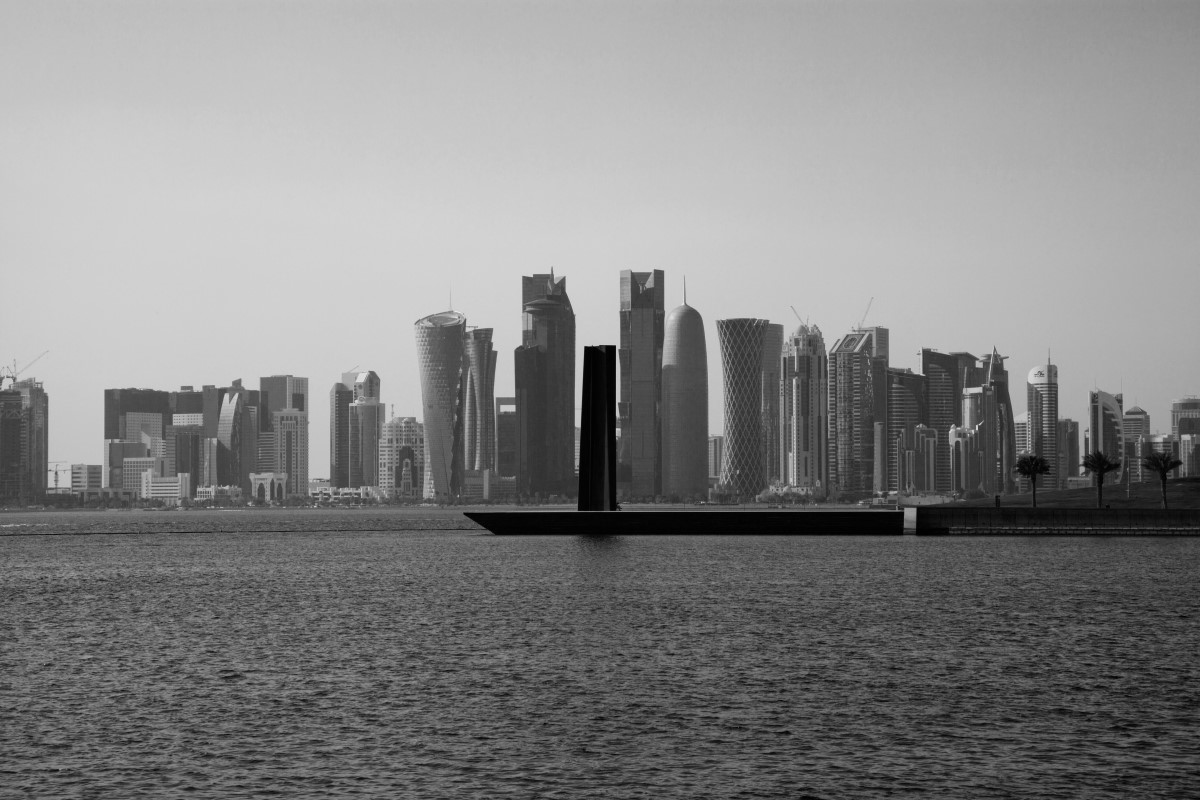
© RICHARD SERRA, published by Steidl www.steidl.de
Despite Serra’s insistence on the political neutrality of the piece, it’s hard not to read the installation of four towering plates of steel in the virgin desert as a wry observation on the speed and scale of Qatar’s own development incentives.
By Eugenie Shinkle, ASX, July 2015
In 1981, Richard Serra’s sculpture Tilted Arc was erected in the plaza in front of the Jacob K. Javits federal building in New York City. Intended to make visitors aware of their movement through the plaza, the 120-foot span of solid Cor-Ten steel sliced the space in half, disrupting the flow of foot traffic. Within months of its installation, over 1000 federal employees had signed a petition for its removal. In 1985, a public hearing was conducted to decide the fate of the sculpture. Four years later, despite a decisive vote to preserve the work, Tilted Arc was removed and placed in storage, where it remains to this day.
Tilted Arc brought into sharp focus a specifically political dimension of Serra’s abstract sculpture. As well as exploring the properties of the materials out of which it was constructed and changing the way that the visitor experienced the site, Tilted Arc commented on the institutional control of space and the restriction of movement by ideological as well as physical means.
Serra’s recent installation, East-West/West-East (2014), commands an even more extensive stretch of terrain – over a kilometre of desert in the Brouq Nature Reserve on the western side of the Qatar peninsula. This is Serra’s second public commission for the Qatar Museums Authority – an organisation that is estimated to spend approximately a billion dollars a year on art.
The work consists of four steel plates between 14 and 16 meters in height, installed in a natural corridor between two limestone outcrops. Despite its enormous scale, its full meaning is meant to be grasped by walking the distance between the plates and reflecting on their relationship to the site. But visitors must drive an hour out into the desert to reach the work, and in a place where summer temperatures can reach 50 degrees Celsius, those who can afford to travel to see East-West/West-East will almost certainly survey it from the comfort of a vehicle.

© RICHARD SERRA, published by Steidl www.steidl.de
Where his earlier site-specific works subtly modify the movement of the individual visitor in relation to their immediate environment, East-West/West-East evokes a kind of capitalist sublime that finds its expression in gargantuan feats of spatial domination.
Despite Serra’s insistence on the political neutrality of the piece, it’s hard not to read the installation of four towering plates of steel in the virgin desert as a wry observation on the speed and scale of Qatar’s own development incentives. And Serra’s own remark that the work provides a point of reference, creating a place where there wasn’t one before, echoes the hubris of a frontier mentality that views the open landscape as terrain to be improved. Where his earlier site-specific works subtly modify the movement of the individual visitor in relation to their immediate environment, East-West/West-East evokes a kind of capitalist sublime that finds its expression in gargantuan feats of spatial domination.
But I digress. On my desk is a catalogue – beautifully produced by Steidl in collaboration with the Qatar Museums Authority – released to mark both the inauguration of East-West/West-East, and a retrospective of Serra’s work held in Doha in 2014. The volume is lavishly illustrated, and Alfred Pacquement’s concise, informative text guides the reader through five decades of Serra’s practice. Elegant as it is, however, the book feels like a justification for a work that ultimately says more about the financial engines that increasingly drive the production of public art, and about the power of capital, rather than art, to transform space.
Steidl
2014
Dr Eugenie Shinkle is a Reader in Photography at the University of Westminster
(All rights reserved. Text @ Eugenie Shinkle. Images @ Richard Serra and courtesy of Steidl.)





